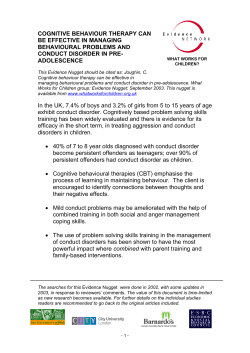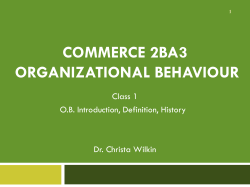
Cognitive-Behavioural Interventions with Children and Adolescents CLINICAL PSYCHOLOGY
Cognitive-Behavioural Interventions with Children and Adolescents CLINICAL PSYCHOLOGY RIVENDELL UNIT 2004 What is CBT? Cognitive behaviour therapy is an “active, directive, timelimited, structured approach….based on the underlying theoretical rationale that an individual’s affect and behaviour are largely determined by the way in which he structures the world” (Beck et al. 1979, p.3). What is CBT? CBT is: – Based on the cognitive model of emotion (see figure on next slide), rather than being a rag-bag of techniques with no unifying rationale. – Brief and time-limited, encouraging patients to develop independent self-help skills (10 – 25 sessions, depending on the disorder). – Problem-oriented and focused on factors maintaining difficulties rather than on their origins. – Educational, presenting cognitive-behavioural techniques as skills to be acquired by practice and carried into the young person’s environment through homework assignments. – Evidence-based and derived from learning theory. Cognitive Model of Emotion Emotion Trigger Thoughts Behaviour It is not simply what happens to you that causes your reactions. Rather, it is the meaning that is attached to an experience that leads a person to feel and behave in certain ways. Cognitive Model of Emotion Example: Stepping in dog poo. Different people will process this situation differently: Some people might begin to think about social embarrassment (“Did anyone see me?”). This style often characterizes anxious people. Some people might become self-denigrating (“I can’t even walk properly”). This may characterise depression. Some might dwell on who was responsible for it (“ whose dog did it..I bet the guy knew someone would step in it”). This may lead to an angry response. Example taken from Kendall (2000). Assessment • Measurement in assessment is essential to a CBT approach. • Behavioural interviewing (antecedents, behaviors, consequences). • Self-monitoring (frequency counts, duration of the problem, self-ratings, diaries). • Self-report questionnaires/interviews (e.g. Achenbach) • Direct observation of the problem (observation of naturally occurring behaviors, role plays, behavioural tests). TREATMENT Two Major Treatment Modalities • Cognitive Therapy is designed to target unhelpful and/or irrational beliefs, attitudes or thoughts. • Behaviour Therapy is designed to target disabling, unproductive or maladaptive behaviours. • Most clinicians use a combintaion of CT and BT = CBT Cognitive Therapy CT involves: The identification of unhelpful, negative thoughts or beliefs using monitoring forms. 1. The detection of distortions in thinking patterns, and 2. The challenging of cognitive distortions and the development of a more helpful, adaptive way of thinking: 1. What is the evidence for the thought? 2. Is there an alternative, more helpful way of thinking? Behaviour Therapy Exposure • Exposure refers to a variety of techniques that involve bringing a young person into contact with the feared stimulus. • Fears are faced gradually, working from the least difficult to the most difficult.. • The child must stay in the feared situation long enough to learn that the bad things that he/she fears will not happen. • Practice and repetition are the keys to success. Behaviour Therapy Activity /Pleasant Event Scheduling • Changing what a person does also changes how they feel. • Patients plan and record their activities for each day and rate them (0-10) for pleasure, mastery, anxiety or competence. This provides hard data on what patients are actually doing and demonstrates the relationship between mood and activity. • Useful with depressed patients, anxious patients, procrastinators and perfectionists. Behaviour Therapy Relaxation • Rationale must be presented to patients (Wolpe’s theory of reciprocal determinism). • There are various ways to learn to relax, including progressive muscular relaxation, applied relaxation and meditation. • Techniques should be practiced at home, using tape recorded instructions. • Helps children learn to have control over their symptoms. • Particularly useful with young people with anxiety disorders and chronic headaches. Behaviour Therapy Problem Solving Why? 1) Assists young people in recognising the resources they have for dealing with problems. 2) Teaches young people a method for overcoming current problems. 3) Enhances their sense of control over problems 4) Equips them with a method for tackling future problems. Behaviour Therapy Problem Solving 1. 2. 3. 4. 5. 6. What is the problem? What could I do? (brainstorm all possible solutions) What might happen if? (consider consequences for each idea). Pick best solution. Do it. Did it work? Behaviour Therapy Contingency Management • Based on operant conditioning principles (a behaviour that is followed by a satisfying consequence will tend to be a repeated behaviour and a behaviour followed by unpleasant consequences will occur less frequently). • Shaping, positive reinforcement and extinction are the most common. • Use of reward systems are very effective when working with children and adolescents across a number of different disorders. The Use of CBT with Young People • Be aware of the developmental stage of the young person (think about psychological, cognitive and emotional development). • Involve family. • Make it interesting and engaging: – – – – – Use of cartoons. Use of favourite superheroes. Role plays. Use age-appropriate language. Use of worksheets – make them fun and colourful, use of reminders at home. Reference Kendall, P.C. (2000). Child and Adolescent Therapy: Cognitive-Behavioural Procedures. The Guildford Press, New York.
© Copyright 2025

![COC203 Marketing Management [4 Credits] on the tools and](http://cdn1.abcdocz.com/store/data/001102194_1-22e098146de29d453ae33d51171034d9-250x500.png)



















